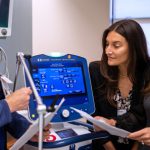 UPMC has a dedicated team of financial counselors who work with patients to get them the financial assistance they need. Here are some common questions and answers about our program.
UPMC has a dedicated team of financial counselors who work with patients to get them the financial assistance they need. Here are some common questions and answers about our program.
Who is eligible for assistance? What if you have insurance?
Patients who have limited or no health insurance, demonstrate financial need, reside in the primary service area of a UPMC hospital, and supply UPMC with necessary household finance information may be eligible to receive assistance. Some patients with insurance might still be eligible for financial assistance, depending on the amount of coverage available to them.
When should I apply for financial assistance—before or after I get the bill?
It is best to apply for financial assistance after receiving the first bill. You can apply any time during or after your treatment up until the resolution of your UPMC account. Should your financial situation change over the course of your care, you can reapply for financial assistance.
What factors are used to determine eligibility for financial assistance?
UPMC considers a multitude of factors when determining if a patient is eligible for financial assistance, including, but not limited to:
- Income level in relation to federal poverty guidelines
- Family size
- Access to insurance
- Residency
How is the amount of financial assistance determined?
UPMC applies a sliding scale to determine a reasonable and fair amount of financial assistance for each patient. Some amount of financial assistance is given to all uninsured patients whose income is below 400 percent of the federal poverty guidelines (that’s $95,400 for a family of four in 2014).
- Patients at or below 200 percent of the federal poverty guidelines:
These patients are eligible for 100 percent financial assistance with the exception of copays. The fees for UPMC services are completely waived.
- Patients between 201 and 400 percent of the federal poverty guidelines and above:
Uninsured – These patients are eligible for an 85 percent reduction in the charges from UPMC hospitals, meaning they are responsible for 15 percent of the total charges. They are also eligible for a 75 percent reduction in charges from UPMC physicians, meaning the patient is responsible for 25 percent of the total charges.
Underinsured patients or patients with incomes exceeding 400 percent of the federal poverty guidelines: These patients may be eligible for assistance if their patient responsibility is above 15 percent of their annual income.
What UPMC services CAN be covered with financial assistance?
Financial assistance can apply to charges incurred from UPMC hospitals or UPMC physicians, including:
- Emergency care
- Nonelective services outside of the Emergency Department to treat life-threatening conditions
- Other medically necessary services
What services CANNOT be covered with financial assistance?
Financial assistance is not usually available to cover insurance copayments, and patients who opt out of available insurance coverage are ineligible. International patients who come to Pennsylvania to receive care at UPMC are also ineligible for financial assistance.
Most clinical services are covered by UPMC’s Financial Assistance Program, but there are some exclusions, including, but not limited to:
- Cosmetic services
- Transplant-related services
- Bariatric-related services
- Elective reproductive services
- Acupuncture
- Private duty nursing
- Dental services
- Services deemed noncovered by Medicare
When all charges associated with a procedure are not covered by financial assistance, who pays the rest?
The patient is responsible for any remaining balances or any balance that financial assistance does not cover.
What about coverage for drugs and prescriptions? Can UPMC help with that, too?
Financial assistance does not cover prescriptions. Social workers may be able to assist patients in applying for assistance with a specific prescription through the drug companies.
Where does the financial assistance money come from?
Each year, UPMC contributes significant funds to the Financial Assistance Program. In fiscal year 2014, UPMC provided $364 million in charity care; $130 million was given to patients through the Financial Assistance Program, and the remaining $216 million went towards subsidized government programs, meaning that when the government does not pay the full cost of a patient’s care, UPMC makes up the difference.
How many people receive financial assistance each year?
In fiscal year 2014, UPMC helped over 64,000 patients through the Financial Assistance Program. This is a 25 percent increase from 2013.
What is the best way to contact the financial assistance department?
To speak with a financial assistance counselor, call the UPMC Financial Assistance Program at 1-800-371-8359 and select the second option. Patients with questions can also visit the Financial Assistance Program website.









